Trapezius Muscle (Excerpt)
Trapezius Sections:
- About the Trapezius
- Common Symptoms
- Causes and Perpetuation of Trigger Points
- Helpful Hints
- Self-Help Techniques
- Also See
About the Trapezius
The trapezius commonly contains trigger points, and referred pain from these trigger points bring patients to the office more often than for any other problem. As you can see from the picture, the trapezius is a large kite-shaped muscle, covering much of the back and posterior neck.
There are three main parts to the muscle: the Upper, middle, and lower trapezius, and each part has its own actions and common symptoms.
Common Symptoms
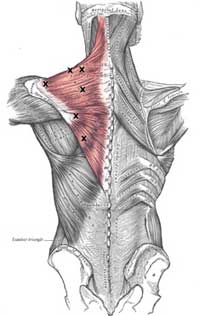 Upper Trapezius
Upper Trapezius
- headaches on the temples / "tension" headaches
- facial, temple, or jaw pain
- pain behind the eye
- dizziness or vertigo (in conjunction with the sternocleidomastoid muscle)
- severe neck pain
- a stiff neck
- limited range-of-motion
- intolerance to weight on your shoulders
Middle Trapezius
- mid-back pain 1
- headaches at the base of your skull 2
- TrP5 refers superficial burning pain close to the spine
- TrP6 refers aching pain to the top of the shoulder near the joint 3
Lower trapezius
- mid-back, neck, and/or upper shoulder region pain 4
- possibly referral on the back of the shoulder blade, down the inside of the arm, and into the ring and little fingers (TrP7), very similar to a serratus posterior superior referral pattern
- headaches at the base of the skull 5
- TrP3 can refer a deep ache and diffuse tenderness over the top of the shoulder 6
Trigger Point Images - Trapezius
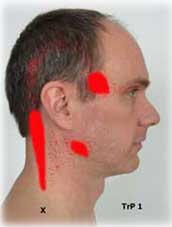 |
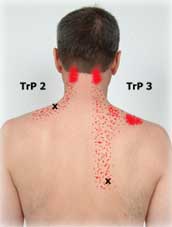 |
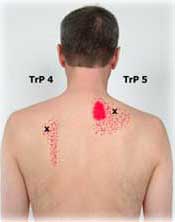 |
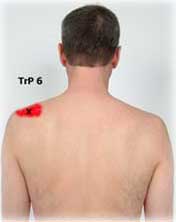 |
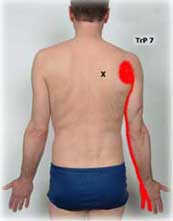 |
Causes and Perpetuation of Trigger Points
- one leg shorter than the other
- a hemipelvis that is smaller on one side (the part of the pelvis you sit on)
- short upper arms (which causes you to lean to one side to use the armrests)
- large breasts
- fatigue
- tensing your shoulders
- cradling a phone between your ear and shoulder
- a chair without armrests, or the armrests are too high
- typing with a keyboard too high
- sewing on your lap with your arms unsupported
- jogging
- sleeping on your front or back with your head rotated to the side for a long period
- playing a violin 7
- sports activities with sudden one-sided movements
- sitting without a firm back support (sitting slumped)
- backpacking
- bike-riding
- kayaking
- any profession or activity that requires you to bend over for extended periods (i.e.. dentists/hygienists, architects/draftsmen, and secretaries/computer users) 8
- bra straps that are too tight (either the shoulder straps or the torso strap)
- a purse or daypack that is too heavy
- a mis-fitting, heavy coat 9
- carrying a day pack or purse over one shoulder -- even if you think you are not hiking up one shoulder, you are, no matter how light the item
- whiplash (a car accident, falling on your head, or any sudden jerk of the head) 10
- head-forward posture 11
- walking with a cane that is too long
- turning your head to one side for long periods to have a conversation 12
- tight pectoralis major muscles 13
Helpful Hints
- If you have a body asymmetry or short upper arms, see a specialist to get compensating lifts or pads.
- Modify or replace your mis-fitting furniture. Your knees should fit under your desk, and the chair needs to be close enough that you can lean against your backrest. Your elbows should rest on either your work surface or armrests at the same height. Your elbows and forearms should rest evenly on the armrests. Your computer screen should be directly in front of you, and the copy attached to the side of the screen, so that you may look directly forward as much as possible.
- If you must bend over reading materials or plans (such as a draftsman, engineer, or architect), a tilted work surface will alleviate the mechanical stress to a point, but be sure to take frequent breaks.
- Get a headset or speaker for your phone, or hold the phone with one hand. Shoulder rests are not adequate.
- Wear bras that fit properly.14 If you see elastic marks on your skin after you take your bra off, the straps are too tight. Jogging bras work great for medium or small-breasted women. Have the salesperson help you find a bra that fits properly -- many of them really know their products. 15
- If you have a foam rubber pillow, get rid of it! Vibrations from these pillows will aggravate trigger points.16 Your pillow should support your head at a level that is comfortable when you are laying on your side (not too high or too short). I always take my pillow with me when I travel -- I know I have something comfortable to sleep on, and it comes in handy if I get stuck in an airport.
- If your breasts are large enough that they cause backaches, your insurance company may cover breast reduction surgery if your doctor recommends it. Carefully consider the risks of surgery if you are considering this option.
- Wear your daypack over both shoulders. If you carry a purse, get one with a long strap and put the strap over your head, so you are wearing it diagonally across your torso, and keep its contents light.
- If you backpack, try to put most of the weight on your hip strap.17
- Restoration of proper posture, especially head positioning, is critical to treating trigger points since head-forward posture can both cause and perpetuate trigger points. Head-forward posture can be aggravated while sitting in a car, at a desk, in front of a computer, or while eating dinner or watching TV. Using a good lumbar support everywhere you sit will help correct poor sitting posture.18 See the video below for postural re-training.
- Any time you must sit for long periods, take frequent breaks. Setting a timer across the room can ensure you must get up to turn it off.
- When having a conversation, turn and face the person rather than rotating your head in their direction.
- Putting your hands in your pockets when standing takes the weight off the trapezius muscle.
- Putting shoulder pads in a heavy coat can help take the weight off the upper trapezius. 19
- If you are unable to relieve your pain with trigger point self-help techniques, you may need to see a doctor to rule out occipital neuralgia and cerviocogenic headaches. You may need to see a chiropractor or osteopathic physician to be evaluated for vertebrae that are out-of-alignment. 20
Self-Help Techniques
General Guidelines for using these self-help techniques are discussed in detail on the CD-ROM. Click here to order. Please note that you may make the pain worse if you do not follow the proper guidelines as shown on the CD-ROM.
Applying Pressure
- Lay face-up on a firm bed or the floor, with your knees bent. Using a tennis ball or racquet ball, start at the shoulder, about one inch out to the side of the spine, and hold pressure eight seconds to one minute per spot. Scoot a small amount to the next spot further down the back, and continue to hold pressure on each spot. Continue until you get to the bottom of the rib cage (the video demonstrates going all the way to the top of the pelvis, but for the trapezius, you only need to go to the bottom of the rib cage). You may want to repeat this on a second line further out from the spine, especially if you have a wide back, or tender points further out. Do not do this directly on the spine!
- Place your elbow and forearm on a surface high enough to support the weight of your arm. With the opposite hand, tilt your head slightly toward the side you are working on, reach across your front and pinch the upper portion of the trapezius muscle. Be sure to stay on the meat of the muscle, and do not dig your thumb into the depression above the collar bone.21
 (3 MB) *This video clip not available to demo. Please purchase the CD-ROM to view the full-content of this section.
(3 MB) *This video clip not available to demo. Please purchase the CD-ROM to view the full-content of this section.
- The supraspinatus muscle self-help will also treat the upper trapezius. Stand in a doorway and place a tennis ball in the groove in the doorjamb, and continue to hold onto the ball with your opposite hand. Bend over at about 90 degrees, and be sure to let your head go completely limp! Lean into the ball with however much pressure you want to apply. Still holding onto the ball with your opposite hand and continuing to keep your head fully relaxed, work spots across the top of the shoulder.
 (2.4 MB) *This video clip not available to demo. Please purchase the CD-ROM to view the full-content of this section.
(2.4 MB) *This video clip not available to demo. Please purchase the CD-ROM to view the full-content of this section.
- To work on the back of your neck, use a golf ball, and lay face up with your hands behind your neck. One palm should be squarely over the other palm, with the golf ball in the center of the top palm (not where the fingers join the palm!). To apply pressure, rotate your head toward the ball (do not put the ball directly on the spine, but on the muscles to the side of the spine). To move the ball, roll your head away from the side you are working on, move the ball a small amount, then rotate your head back toward the side you are working on. If you want more pressure, rotate your head toward the side you are working on even more, and rotate your head less if you want less pressure. Do not pick your head up to move the ball! This will cause additional stress on the muscles. Be sure to move the ball by rotating your head away from the ball. You may work along the base of the skull, down the back of your neck, and try to get all the way to the base of the neck where it intersects the top of the shoulder.22
 (7.6 MB) *This video clip not available to demo. Please purchase the CD-ROM to view the full-content of this section.
(7.6 MB) *This video clip not available to demo. Please purchase the CD-ROM to view the full-content of this section.
Stretches
- See the video for a stretch that benefits the middle and lower trapezius.23
 (4.5 MB) *This video clip not available to demo. Please purchase the CD-ROM to view the full-content of this section.
(4.5 MB) *This video clip not available to demo. Please purchase the CD-ROM to view the full-content of this section.
- You will need to watch the video to see the exact angles of the Posterior Neck stretch. You may do this under a hot shower, if possible seated on a stool.24
 (3.8 MB) *This video clip not available to demo. Please purchase the CD-ROM to view the full-content of this section.
(3.8 MB) *This video clip not available to demo. Please purchase the CD-ROM to view the full-content of this section.
- The pectoralis stretch will benefit the trapezius muscle. Stand in a doorway and place your forearm along the sill, including your elbow. With the foot of the same side placed about one step forward, rotate your body gently away from the side you are working. Move your forearm up to about 45-degrees and repeat. Bring the forearm down below the first position and repeat. These positions will stretch different parts of the muscle.25
 (4.1 MB) *This video clip not available to demo. Please purchase the CD-ROM to view the full-content of this section.
(4.1 MB) *This video clip not available to demo. Please purchase the CD-ROM to view the full-content of this section.
Exercises
- Swimming provides good aerobic exercise, and does not place impactful stresses on the muscles. Vary your strokes so you do not unduly stress the trapezius.26 Turning your head to one side, as with the crawl stroke, can aggravate the trapezius.27
- Jump rope while moving forward.28
- Stand with your feet about four inches apart, with your arms at your sides and thumbs pointing forward. Tighten your buttocks to stabilize your lower back, then while inhaling, rotate your arms and shoulders out and back (rotating your thumbs backward) and squeeze the shoulder blades together in the back. Keep holding this position while dropping your shoulders down and exhaling. Move your head back to bring your ears in line with your shoulders, and hold this position for about six seconds while breathing normally. (When moving your head, don't move your nose up or down or open your mouth.) Relax, but then try to maintain good posture once you release the pose. If holding this position feels uncomfortable or "stiff," try shifting your body weight from your heels to the balls of your feet, which causes the head to move backward over the shoulders. This exercise should be repeated frequently during the day in order to re-train yourself in good postural techniques, at least every one to two hours. It is better to do one repetition six or more times per day than to do six repetitions in a row.29
 (2.7 MB) *This video clip not available to demo. Please purchase the CD-ROM to view the full-content of this section.
(2.7 MB) *This video clip not available to demo. Please purchase the CD-ROM to view the full-content of this section.
Also See:**
- Supraspinatus
- Sternocleidomastoid
- Levator scapula
- Infraspinatus
- Pectoralis major
- Pectoralis minor
- Rhomboid
- Temporalis (satellite trigger points)
- Facial / Scalp (occipitalis -- satellite trigger points)
- Posterior Neck (satellite trigger points)
- Masseter (satellite trigger points)
** To view these chapters and more, order the complete text and media set on CD-ROM.
© Copyright Valerie DeLaune, LAc, 2004-2018
| <-- Back to "What are Trigger Points?" |
- Janet G. Travell , M.D., and David G. Simons, M.D., Myofascial Pain and Dysfunction: The Trigger Point Manual, vol. I, The Upper Extremities, (Baltimore: Williams & Wilkins, 1983), pp. 183-190.
- Author's experience or education
- Janet G. Travell , M.D., David G. Simons, M.D., and Lois S. Simons, P.T., Myofascial Pain and Dysfunction: The Trigger Point Manual, vol. I, Upper Half of Body, 2nd ed. (Baltimore: Williams & Wilkins, 1999), pg. 281.
- Travell & Simons, M.D.s, Vol. I, pp. 183-190.
- Author's experience or education
- Travell & Simons, M.D.s, Simons, P.T., Vol. I, 2nd ed., pg. 280.
- Travell & Simons, M.D.s, Vol. I, pp. 183-190.
- Author's experience
- Travell & Simons, M.D.s, Vol. I, pp. 189-190.
- Author's experience or education
- Travell & Simons, M.D.s, Simons, P.T., Vol. I, 2nd ed., pg. 262.
- Travell & Simons, M.D.s, Simons, P.T., Vol. I, 2nd ed., pg. 287.
- Travell & Simons, M.D.s, Simons, P.T., Vol. I, 2nd ed., pg. 827.
- Travell & Simons, M.D.s, Vol. I, pp. 189-190.
- Author's experience or education
- Travell & Simons, M.D.s, Vol. I, pg. 196.
- Author's experience or education
- Travell & Simons, M.D.s, Simons, P.T., Vol. I, 2nd ed., pg. 263.
- Travell & Simons, M.D.s, Simons, P.T., Vol. I, 2nd ed., pp. 301-302.
- Travell & Simons, M.D.s, Simons, P.T., Vol. I, 2nd ed., pp. 292-293.
- Author's experience or education
- Author's experience or education
- Travell & Simons, M.D.s, Vol. I, pg. 199.
- Travell & Simons, M.D.s, Vol. I, pg. 319.
- Travell & Simons, M.D.s, Vol. I, pg. 594.
- Travell & Simons, M.D.s, Vol. I, pg. 198.
- Author's experience or education
- Travell & Simons, M.D.s, Vol. I, pg. 198.
- Travell & Simons, M.D.s, Simons, P.T., Vol. I, 2nd ed., pg. 263.
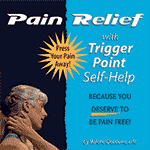
 Trapezius
Trapezius

